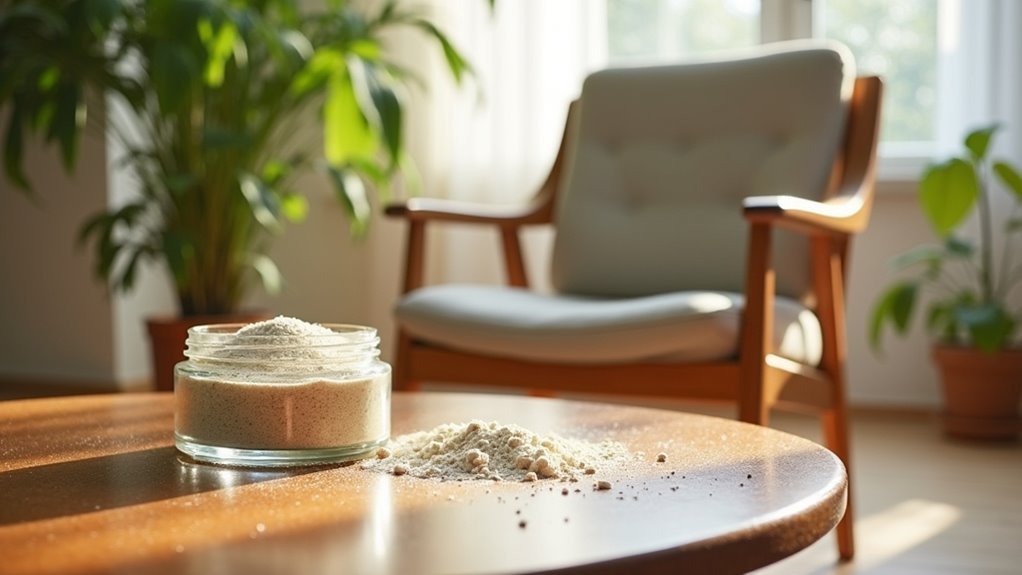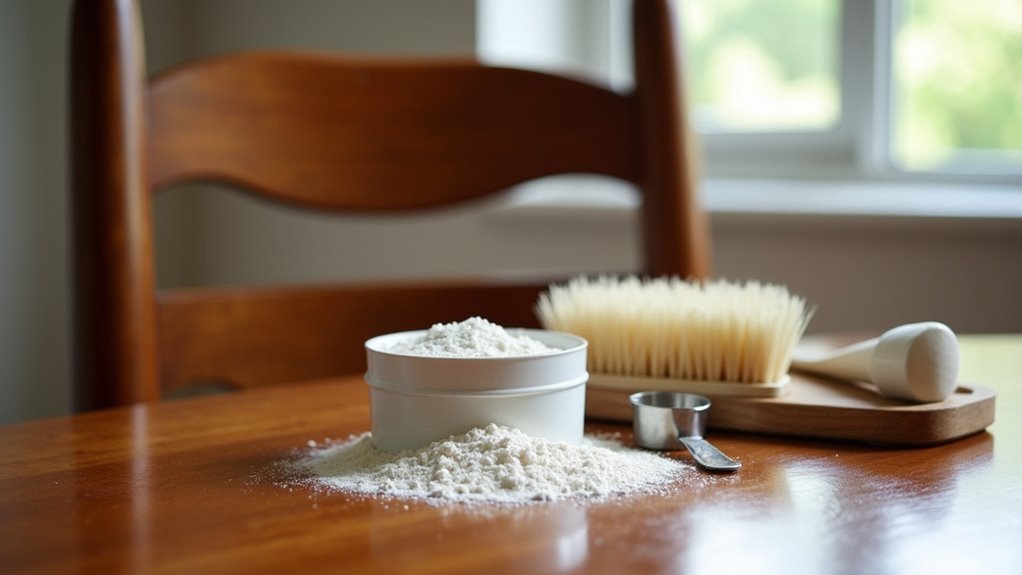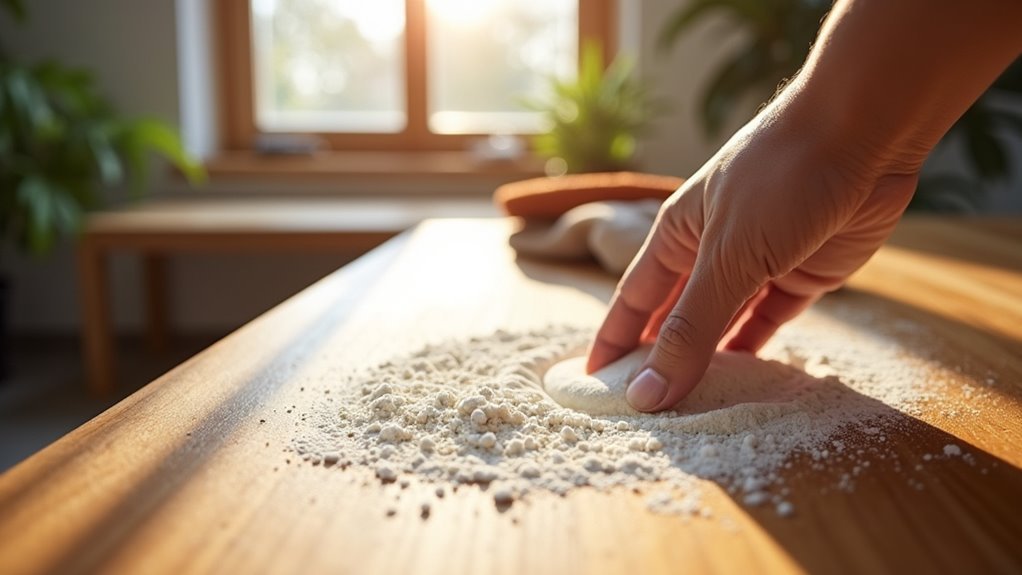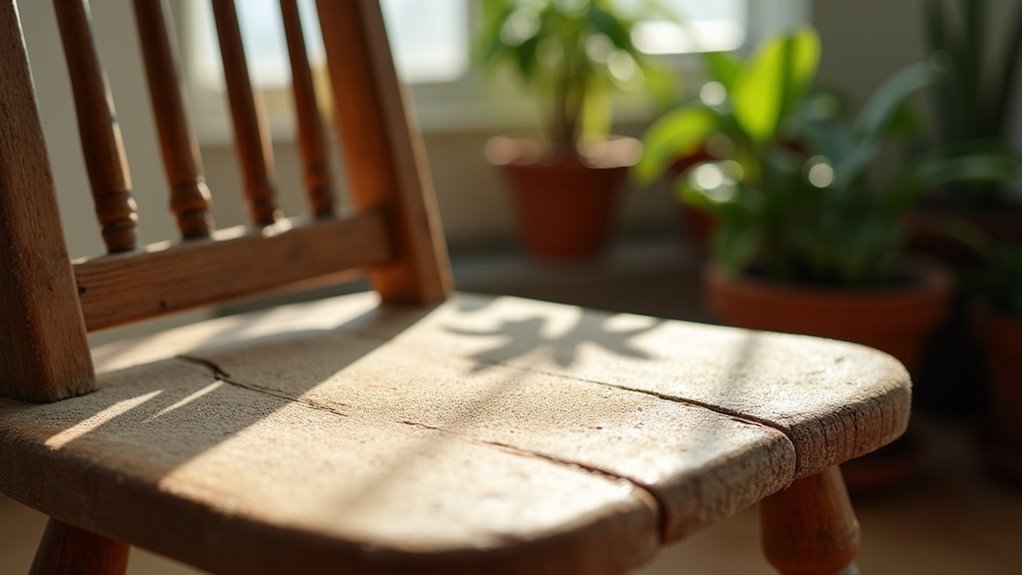Diatomaceous earth furniture treatment involves applying food-grade DE powder to your furniture’s surfaces, seams, and crevices to eliminate bed bugs through physical dehydration. You’ll spread a thin layer using a duster or brush while wearing protective gear, targeting areas where pests hide like mattress seams and furniture legs. The microscopic fossilized diatom shells damage insect exoskeletons and absorb moisture, killing bugs within 7-17 days. This extensive guide reveals the complete application process and professional techniques.
Understanding Diatomaceous Earth and Its Properties

When dealing with furniture pest problems, you’ll want to understand that diatomaceous earth is a naturally occurring powder derived from fossilized diatoms—microscopic algae with hard, silicon dioxide shells that accumulated over millions of years.
This pest control method works through physical action rather than chemicals. DE works by damaging the exoskeleton of insects like bed bugs, causing them to dehydrate and die as the powder absorbs moisture from their bodies.
The sharp-edged particles create a mechanical barrier that restricts insect movement around treated areas. Always choose food-grade diatomaceous earth for home use, as it’s safe around pets and children.
Safety Precautions for Furniture Treatment
Before you begin treating your furniture with diatomaceous earth, you’ll need to prioritize safety by wearing proper protective equipment like gloves and a dust mask.
Always select food-grade DE rather than pool-grade versions, as it’s specifically designed for safe indoor use around your family and pets.
You’ll also want to master correct application techniques that minimize dust clouds and guarantee even distribution across furniture surfaces.
Personal Protective Equipment
Three essential pieces of personal protective equipment will keep you safe while applying diatomaceous earth to furniture.
These items protect you from potential irritation during application and guarantee proper handling of food-grade diatomaceous earth.
- Dust mask – Always wear one to prevent inhalation of fine particles that can irritate your lungs during application.
- Gloves – Use them to protect your skin from dryness and irritation caused by prolonged contact with diatomaceous earth.
- Eye protection – Wear goggles to avoid irritation from DE dust that may accidentally become airborne during treatment.
Additionally, guarantee proper ventilation in your work area to minimize inhalation risks and enhance overall safety while treating furniture with diatomaceous earth.
Food Grade Selection
Beyond wearing proper safety gear, you must select the right type of diatomaceous earth for furniture treatment. Always choose food grade diatomaceous earth containing less than 1% crystalline silica, guaranteeing it’s safe around humans and pets.
Verify your selection is free from additives or pesticides that could harm your family or reduce effectiveness.
When you apply diatomaceous earth, use a dust mask to prevent inhalation of fine particles. Apply a thin layer evenly across furniture surfaces, targeting areas where pests hide or travel. This maximizes the desiccant properties essential for Diatomaceous Earth for Pest control success.
After application, allow to remain on furniture for several days before vacuuming. This extended contact time guarantees the DE effectively eliminates pests through dehydration.
Proper Application Techniques
Five essential steps guarantee safe and effective diatomaceous earth application on furniture. You’ll need proper protective gear and systematic application techniques for effective pest control against bed bugs and other unwanted invaders.
Before beginning your application of diatomaceous earth, confirm you’re wearing a dust mask and gloves to avoid breathing harmful particles and prevent skin irritation.
Clean and dry your furniture completely to maximize the food-grade DE’s effectiveness.
Follow these critical application steps:
- Dust lightly – Apply a thin layer using a duster or brush on furniture legs, seams, and crevices where pests hide.
- Wait patiently – Leave undisturbed for one full week to confirm maximum pest contact.
- Clean thoroughly – Remove residue with a filterless vacuum cleaner or shop vac.
Selecting the Right Type of Diatomaceous Earth
When choosing diatomaceous earth for treating furniture, you’ll want to select food-grade DE exclusively, as it’s safe for use around your family and pets while effectively targeting pests. Food-grade diatomaceous earth contains less than 1% crystalline silica, making it ideal for furniture treatment applications. Avoid pool-grade or industrial-grade varieties due to health risks.
| Feature | Food-Grade DE | Pool/Industrial Grade |
|---|---|---|
| Crystalline Silica | <1% | 60-70% |
| Safety Rating | Safe indoors | Health hazardous |
| Pest Control Effectiveness | High | Variable |
Look for products specifically labeled for pest control to guarantee effectiveness against bed bugs and other furniture-infesting pests. Choose finely milled DE for even application and maximum surface adherence. Consider bulk purchasing to reduce costs and guarantee adequate supply for thorough treatment.
Essential Tools and Materials for Application

You’ll need specific tools and safety equipment to apply diatomaceous earth effectively on your furniture.
Start by gathering a dust mask, gloves, and a duster or brush for even powder distribution across surfaces.
Don’t forget a vacuum with HEPA filtration for cleanup and a re-sealable container to store any leftover DE.
Required Application Tools
Before applying diatomaceous earth to your furniture, gather the proper tools to guarantee safe and effective treatment. Your application tools must prioritize safety and precision to achieve ideal results.
Essential safety equipment includes:
- Dust mask and gloves – Protect your respiratory system and skin from DE particles during application
- Duster or feather duster – Distribute a fine layer evenly across furniture surfaces and crevices
- Vacuum cleaner with HEPA filter – Clean up excess powder without damaging your equipment
You’ll also need measuring tools like plastic spoons for scooping and brushes for detailed work around furniture edges.
A shop vac works best for cleanup since regular vacuums can clog. Store remaining diatomaceous earth in re-sealable containers to maintain effectiveness between treatments.
Safety Equipment Essentials
Since diatomaceous earth particles can irritate your respiratory system and skin, proper safety equipment isn’t optional—it’s mandatory.
You’ll need a dust mask to prevent inhaling fine particles that can damage your lungs during application. Protective gloves are essential to avoid skin irritation and dryness from prolonged contact with DE. Eye protection, such as safety goggles, shields against accidental dust particles entering your eyes while you’re applying the treatment.
Always use food-grade diatomaceous earth for indoor use, as it’s considerably safer than pool-grade or industrial varieties.
Your application tools should include a duster for even distribution, a plastic spoon for scooping, and a soft brush for working diatomaceous earth into furniture cracks and crevices effectively.
Preparing Furniture and Treatment Areas
When treating furniture with diatomaceous earth, proper preparation greatly increases your chances of success against bed bugs.
Before you apply this fine powder, you’ll need to create ideal treatment areas for maximum effectiveness.
Start by thoroughly cleaning your furniture and surrounding spaces:
- Vacuum everything completely – Remove existing bed bugs, eggs, and debris from all surfaces, paying special attention to cracks and crevices where these pests hide.
- Move furniture away from walls – Create clear access to all sides, allowing you to reach every potential hiding spot and travel route.
- Inspect and identify target areas – Locate all joints, seams, and crevices in your furniture where bed bugs typically congregate.
This thorough preparation guarantees the diatomaceous earth reaches all critical areas during treatment.
Step-by-Step Application Process

The actual application of diatomaceous earth requires precision and patience to achieve effective bed bug control.
Start by thoroughly vacuuming your furniture, targeting seams and crevices where bed bugs hide. Use a dusting tool like a feather duster or paintbrush to apply a thin, even layer of food-grade DE across furniture surfaces. Focus particularly on edges and joints where bed bugs typically travel during their nocturnal activities.
Allow the DE treatment to remain undisturbed for at least one week. This extended exposure time guarantees the powder can effectively dehydrate any bed bugs that contact it.
Monitor your furniture regularly for signs of continued bed bug activity, such as live insects or new bite marks. Reapply DE as needed, especially after cleaning or when you notice renewed pest activity, maintaining consistent protection against these persistent household invaders.
Monitoring Treatment Effectiveness
After applying diatomaceous earth to your furniture, you’ll need to carefully track its performance against bed bugs over the coming weeks.
Remember that DE bed bug treatment requires patience, as it can take 7 to 17 days for bugs to die after exposure. Monitor for new bites and watch for visible bed bugs or fecal spots in treated areas to assess effectiveness.
Here’s how to monitor your pest control progress:
- Weekly vacuum routine – Clean up DE weekly to check for dead bugs and maintain treatment effectiveness.
- Document activity levels – Record any bed bug sightings or bite occurrences to track improvement.
- Strategic reapplication – Reapply DE in high-traffic areas or after disturbances to maintain protective barriers.
Consistent monitoring guarantees your diatomaceous earth treatment delivers ideal results against bed bug infestations.
Reapplication and Maintenance Schedule
Since diatomaceous earth loses potency over time, you’ll need to establish a consistent reapplication schedule every 7 to 10 days to maintain effective bed bug control on your furniture.
Reapply diatomaceous earth every 7-10 days since it loses effectiveness over time for consistent bed bug furniture protection.
Monitor activity regularly and reapply immediately when you detect new infestations, especially around furniture legs and high-traffic areas.
After vacuuming up DE, promptly restore the protective barrier with a fresh thin layer, keeping pets and children away for 24 hours.
Humid conditions or spills require immediate reapplication to maintain effectiveness.
Consistent monitoring and reapplication after cleaning or disturbance guarantees long-term pest control success.
This diatomaceous earth furniture treatment schedule prevents re-infestation and keeps your furniture protected against bed bugs throughout your treatment period.
Combining With Other Pest Control Methods
While maintaining your regular diatomaceous earth schedule provides solid protection, combining DE with complementary pest control methods greatly enhances your bed bug elimination efforts.
Integrated pest management approaches create multiple attack points that considerably improve your success rate.
Here are three effective combinations for enhanced bed bug control:
- Heat Treatment + DE Application – Use heat devices like ZappBug Heater to eliminate all life stages, then apply diatomaceous earth to target remaining hidden bugs and prevent recolonization.
- Vacuuming/Steam + DE Barrier – Remove visible pests through vacuuming and steam cleaning, then create protective DE barriers around treated furniture to prevent re-infestation.
- Insect Growth Regulators + DE – Apply IGRs to disrupt reproduction cycles while applying diatomaceous earth for adult elimination, requiring regular monitoring and strategic reapplication of DE for best results.
Frequently Asked Questions
Do I Vacuum After Using Diatomaceous Earth?
You should vacuum after using diatomaceous earth, but wait at least a week first. Use a filterless vacuum to avoid clogging, vacuum slowly to minimize dust, and guarantee proper ventilation during cleanup.
Can You Sleep in a Room After Using Diatomaceous Earth?
You can sleep in a room after using diatomaceous earth once it’s settled and visible piles are cleaned up. Wait a few hours after application to minimize inhalation risks and guarantee safety.
What Are the Downsides of Diatomaceous Earth?
You’ll face respiratory irritation if you inhale DE dust, potential skin dryness from contact, limited effectiveness against soft-bodied pests, and serious health risks if you accidentally use industrial-grade instead of food-grade varieties.
Can I Sprinkle Diatomaceous Earth on My Furniture?
You can sprinkle food-grade diatomaceous earth on furniture to control bed bugs. Apply thin, even layers in seams and crevices, wear protective gear, and leave it for a week.
In Summary
You’ve learned how diatomaceous earth can effectively treat furniture infestations when you apply it correctly. Remember to use food-grade DE, wear protective gear, and follow proper application techniques. You’ll need to monitor results regularly and reapply as necessary. Don’t forget that combining DE with other pest control methods often yields better results. Stay consistent with your treatment schedule, and you’ll successfully eliminate unwanted pests from your furniture while maintaining a safe environment.





Leave a Reply